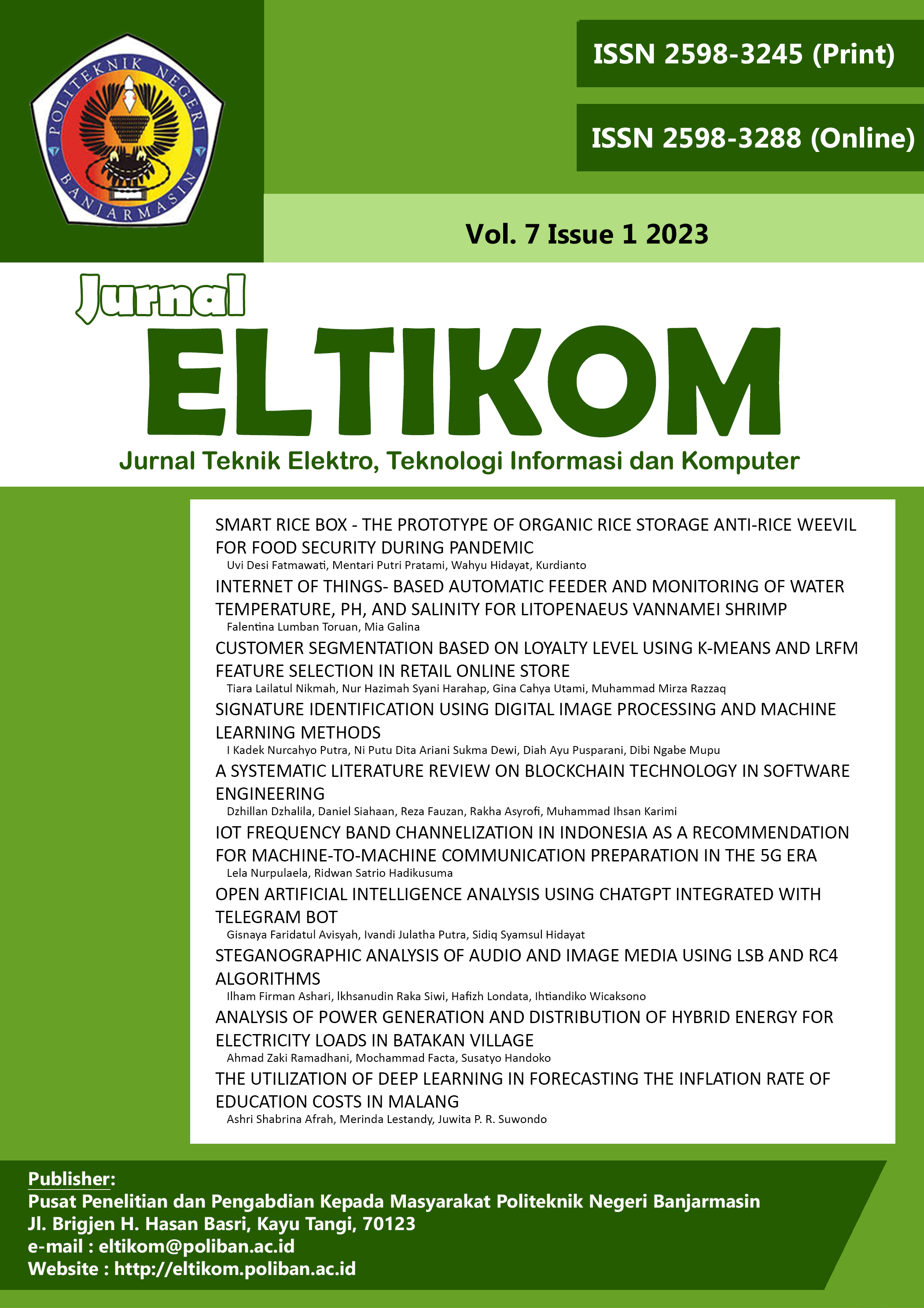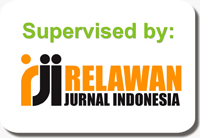Analysis of Power Generation and Distribution of Hybrid Energy for Electricity Loads in Batakan Village
DOI:
https://doi.org/10.31961/eltikom.v7i1.767Keywords:
Hybrid Power Plant, Solar Power Plant, Wind Power PlantAbstract
The need for electrical energy continues to increase over time. However, in Indonesia power plants are still dominated by fossil fuel power plants, and there are still many areas without access to electricity. The use of renewable energy is needed to replace fossil fuels considering that fossil fuels can run out one day. The coastal area of Batakan Village in Tanah Laut Regency, South Kalimantan Province, was chosen as the focus location for conducting hybrid power plant simulations because this village is located in a coastal area where wind and solar energy sources are abundant. Batakan Village is approximately 40 km from Pelaihari City. Medium-voltage network transmission system (JTM) is supplied from Pelaihari City, and it is almost certain that this village experiences large power losses over long distance. This power loss will be detrimental if an effort is not made to reduce it. The purpose of this research is first to determine the optimal hybrid power plant configuration design to reduce power loss in the electricity system in Batakan Village. Second, it will analyze the power loss of the hybrid power plant system in Batakan Village, and finally, this research is going to analyze the investment feasibility of the hybrid power plant system in Batakan Village. In this study, the design of renewable energy plants, such as solar power plants (PLTS) with a total capacity of 406.1 kW and wind power plants (PLTB) with a total capacity of 125 kW, and the electricity network (grid system) are used together in a hybrid power generation system. The ETAP software was used to analyze the power losses of the hybrid power generation system, while the HOMER software was used to determine the net present value (NPV) and cost of energy (COE) of the hybrid power generation system. The results show that the configuration of the solar, wind, and grid systems is the most optimal. It is obtained from the results of ETAP simulations that have been carried out during average load and peak load conditions that by including the Solar Power Plant and Wind Power Plant power losses in the electricity system in Batakan Village can be reduced from the previous one using the system configuration only connected to the PLN power grid (grid system only). The total power losses incurred was 269.1 kW of active power and 1613.5 kvar of reactive power at average load reduced to 266.9 kW of active power and 1568.9 kvar of reactive power. At peak load the total power losses were 423.4 kW of active power and 2573.0 kvar of reactive power and they deceased to 41.,5 kW of active power and 2510.5 kvar of reactive power. In terms of investment, the COE value decreased by IDR 111, and the NPC decreased by IDR 6,600,000,000 at the average load. At the peak load COE decreased by IDR 88, while NPC by IDR 7,000,000,000. The return of investment (ROI) value is 13.2%, which indicates that the investment is still in the profitable stage.
Downloads
References
M. Abrori, S. Sugiyanto, and T. F. Niyartama, “Pemanfaatan Solar Cell Sebagai Sumber Energi Alternatif dan Media Pembelajaran Praktikum Siswa Di Pondok Pesantren ‘Nurul Iman’ Sorogenen Timbulharjo, Sewon, Bantul, Yogyakarta Menuju Pondok Mandiri Energi,†J. Bakti Saintek J. Pengabdi. Masy. Bid. Sains dan Teknol., vol. 1, no. 1, pp. 17–26, 2017.
M. Saputra, “Studi Analisis Potensi Energi Angin Sebagai Pembangkit Listrik Tenaga Angin Di Kawasan Meulaboh,†J. Mekanova Mek. Inov. dan Teknol., vol. 1, no. 1, 2015.
H. F. Sumbung, Y. Letsoin, and J. Merauke, “Analisa dan estimasi radiasi konstan energi matahari melalui variasi sudut panel fotovoltaik SHS 50 WP,†J. Ilm. Mustek Anim Ha, vol. 1, no. 1, 2012.
D. Hidayanti and G. Dewangga, “Rancang bangun pembangkit hybrid tenaga angin dan surya dengan penggerak otomatis pada panel surya,†Eksergi, vol. 15, no. 3, pp. 93–101, 2020.
D. Rekioua and E. Matagne, Optimization of photovoltaic power systems: modelization, simulation and control. Springer Science & Business Media, 2012.
R. Rusman, “Pengaruh Variasi Beban Terhadap Efisiensi Solar Cell Dengan Kapasitas 50 Wp,†Turbo J. Progr. Stud. Tek. Mesin, vol. 4, no. 2, 2017.
M. Fikri and D. Anggaini, “Metode Newton Raphson Untuk Analisis Aliran Daya Jaringan Distribusi 12, 66 kV,†SUTET, vol. 8, no. 2, pp. 114–121, 2018.
B. Kahar, “Studi Dan Pemodelan Penyediaan Energi Di Pulau Moti Kota Ternate Berbasis Energi Terbarukan,†Jur. Tek. Fis. Fak. Teknol. Ind. Inst. Teknol. Sepuluh November, Surabaya, 2016.
A. H. Nebey, “Design of optimal hybrid power system to provide reliable supply to rural areas of Ethiopia using MATLAB and Homer,†Renewables Wind. Water, Sol., vol. 8, no. 1, p. 4, 2021.
X. Lei, T. Shiyun, D. Yanfei, and Y. Yuan, “Sustainable operation-oriented investment risk evaluation and optimization for renewable energy project: A case study of wind power in China,†Ann. Oper. Res., vol. 290, pp. 223–241, 2020.
A. Soba, V. A. Suoth, and H. S. Kolibu, “Optimasi Kapasitas Pembangkit Listrik Tenaga Hybrid (PLTH) di Pulau Bunaken Menggunakan Software HOMER,†J. MIPA, vol. 8, no. 1, pp. 7–12, 2019.
D. Saefrudin, “Analisis Elektric Load Flow (Aliran Daya Listrik) Dalam Sistem Tenaga Listrik Menggunakan Software ETAP Power Station 4.00 Di Pt. Lokatex Pekalongan,†Edu Elektr. J., vol. 4, no. 1, 2015.
K. Kunaifi, “Program homer untuk studi kelayakan pembangkit listrik hibrida di propinsi riau,†in Seminar Nasional Informatika (SEMNASIF), 2015, vol. 1, no. 2.
B. T. Aribowo, S. Setiawidayat, and M. Muksim, “Simulasi dan analisis load flow sistem interkoneksi kalimantan timur menggunakan software ETAP 12.6,†in Conference on Innovation and Application of Science and Technology (CIASTECH), 2018, vol. 1, no. 1, pp. 626–633.
Badan Pusat Statistik Kabupaten Tanah Laut, Kabupaten Tanah Laut Dalam Angka 2020. Tanah Laut, 2020.
Downloads
Published
How to Cite
Issue
Section
License
Copyright (c) 2023 Jurnal ELTIKOM : Jurnal Teknik Elektro, Teknologi Informasi dan Komputer

This work is licensed under a Creative Commons Attribution-NoDerivatives 4.0 International License.
All accepted papers will be published under a Creative Commons Attribution 4.0 International (CC BY 4.0) License. Authors retain copyright and grant the journal right of first publication. CC-BY Licenced means lets others to Share (copy and redistribute the material in any medium or format) and Adapt (remix, transform, and build upon the material for any purpose, even commercially).




